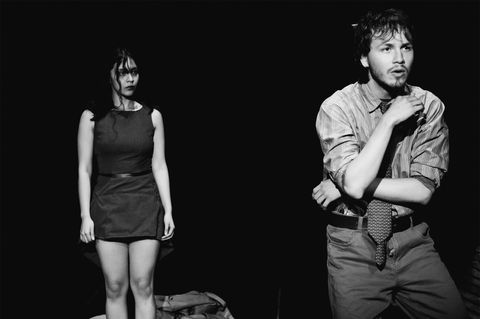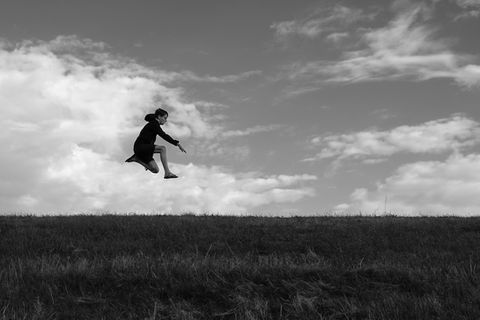
A SENSE OF TIME AND PLACE
October 30, 2020
INTERVIEW
PHOTOGRAPHY Peter Bartlett
INTERVIEW Karin Svadlenak
West Yorkshire photographer Peter Bartlett has a long standing interest in documentary photography dating back to the 1970s. This has evolved into a portfolio that documents everyday life against a backdrop of the ordinary urban landscapes of northern England over the last fifty years. Since his retirement in 2006, Peter has immersed himself in photography, undertaking many different projects, exhibiting his work internationally, gaining several hundred acceptances and receiving numerous awards. In 2010 he was awarded a Licentiate of the Royal Photographic Society (LRPS). A long term project photographing Manchester’s Northern Quarter included a body of work that gained Peter an Associateship of the Royal Photographic Society (ARPS) in 2018. Peter has self-published several books of his work including the titles ‘Shards of West Yorkshire’ volumes one & two, ‘The Northern Quarter’, ‘Various Covered Vehicles’ and ‘Empty Premises’. October 2020 saw the publication of Peter’s 2019 project ‘A Day at the Races’ through ADM Publications.

“I was born in Stockport in Greater Manchester and have lived in different parts of the North of England all my life. I now live near Huddersfield in West Yorkshire. My first experience of photography dates back to the age of around ten when I was given a Halina 35x for Christmas. With this camera I learned about exposure and how to process and print black and white films with the help of my father who was a keen amateur photographer.”
IN CONVERSATION WITH PETER BARTLETT
THE PICTORIAL LIST: Peter, you told us that your interest in documentary photography dates back to the 1970s. Could you tell us more about that?
PETER BARTLETT: As a hobby photographer, most of my images were ‘one-offs’ as opposed to parts of themed sets, but throughout the 70s and 80s I was always fascinated by the work of leading photojournalists and looking back at old prints and images I can see the influence these photographers had on my work.
After a break from photography in the 90s I bought my first DSLR in 2003 - initially my images were fairly eclectic but I was drawn to street photography, making a conscious commitment to that genre around 2010. In recent years this has evolved into themed projects, many of which have become self-published books on the Blurb platform.
TPL: Where do you find your inspiration to photograph?
PB: I'm an inveterate people watcher, so wherever I go, whether I have a camera with me or not I watch, observe and see potential images - not only people but also the urban landscape around them. I guess my inspiration is everyday life.
TPL: You did not grow up in an Internet-based age. (None of our team did either.) How do you feel about the various social media photo platforms that have made sharing photography with a large audience so easy? What advantages and disadvantages do you see in this?
PB: I have used Flickr for many years and more recently Facebook and Instagram. Each platform provides a means of sharing my images and perhaps more importantly viewing the work of others.
Sadly Flickr is a shadow of what it was and I have never really been comfortable with Facebook. When I signed up to Instagram just over two years ago, I was sceptical, but the platform won me over quickly and opened up a number of wider opportunities including contribution to an online exhibition during lockdown, the publication of ‘A Day at the Races’ and of course, this feature.
So, mainly positive although I do have concerns about some of my images being lifted and used by others without permission. But, I guess that’s one of the risks of online life.
TPL: In general, what do you want to express through your photography? And what are some of the elements you always try to include in your photographs?
PB: Now, most of my photography is project based, each image is part of a larger piece of work. Depending on the project, I guess my principal objective is to capture a sense of time and place.
TPL: Do you have any favourite artists or photographers you would like to share with us, and the reason for their significance?
PB: My serious interest in photography evolved during the 1970s and I recall enjoying the early work of Martin Parr along with Chris Killip, Chris Steele-Perkins, Tony Ray-Jones and Homer Sykes. In the late 1970s I was hugely impressed by a major Cartier Bresson exhibition at the V&A Museum in London. Shortly after that I bought a copy of Ian Berry’s book ‘The English’, which I browse now. I’m sure much of this will have stayed with me.
I'm an inveterate people watcher, so wherever I go, whether I have a camera with me or not I watch, observe and see potential images - not only people but also the urban landscape around them.

TPL: Does the equipment you use help you in achieving your vision in your photography? What camera do you use? Do you have a preferred lens/focal length?
PB: Initially I used a DSLR for street photography, usually with a prime lens. Ten years ago, I moved to the micro four thirds system. I’ve had several Olympus bodies and currently use a Pen F with small prime lenses (usually 28mm, 34mm, and 50mm full frame equivalent). I do have other lenses including zooms but use these much less. I also use the Ricoh GR range (currently a GRiii) with its fixed 28mm equivalent focal length.
The move to a more compact kit enabled me to capture images that would have been impossible with a larger camera.
TPL: Your photos show people in your home country, the UK. Do you have a favourite place to photograph in?
PB: As a student I studied the Industrial Revolution and have always been fascinated by the remnants of those times in the Northern post-industrial communities, where I have lived all my life. So, I love to make images against the backdrop of post-industrial landscapes in the communities across the North of England.
TPL: When you go out on the streets, do you have a concept in mind of what you want to shoot, or do you let the images just "come to you", or is it both?
PB: Yes and no. I usually work on several projects at a time. Typically, I’ll have a specific project in mind when I go out to photograph, but I’m constantly on the lookout for images that will fit within other projects, as well as subjects that may be the inspiration for a new project.
TPL: What are some of your goals as an artist? Where do you see yourself or hope to see yourself in five years?
PB: When I moved to a project based approach I hoped that I might create a body of work that captures something of the lives, times and activities of ordinary people in the part of the UK where I live. It will, perhaps, be for others to decide whether I achieve that objective.
Five years seems a long time! The impact of Covid-19 has been significant for me. I’m over 70 years of age and during the spring lockdown I took stock and recognised that the world has changed and things are not likely to return to the way they were. I have no desire to shoot images of people in masks, nor do I think that at my age it will be wise to spend time in busy places shooting street images with a wide angle lens. So I anticipate that my work will focus on urban and post-industrial landscape along with images of quirky subjects that catch my eye. That said, I’m sure that a fair number of images will continue to include people!
TPL: Are there any special projects you are currently working on that you would like to let everyone know about?
PB: The images that illustrate this interview are from my project 'Shards of West Yorkshire'.
In 2016 I embarked upon this long term street photography project hoping to capture something of the essence of the post-industrial communities of West Yorkshire. My plan had been to continue shooting until the end of 2020 and self-publish five books, each of around 65 images. The intervention of Covid-19 in March brought an early conclusion to the planned shoots.
Two books have been published (Vol.1 & Vol.2). I am currently working on Vol.3 and expect to publish this in the New Year. I do have sufficient images for a fourth book, whether there is enough material for a fifth book is something I’ll consider after Vol.4 is published in late 2021.
TPL: "When I am not out photographing, I (like to)…
PB: Listen to music (jazz and classical) and spend time with my family."

Peter Bartlett's long-standing interest in documentary photography has resulted in a unique and interesting portfolio which documents everyday life against a backdrop of the ordinary urban landscapes of northern England. Peter's most recent projects have further enriched his portfolio, allowing us to delve deeper into his creative and thought-provoking work. To view more of his projects and learn more about his work, use the links below.

































